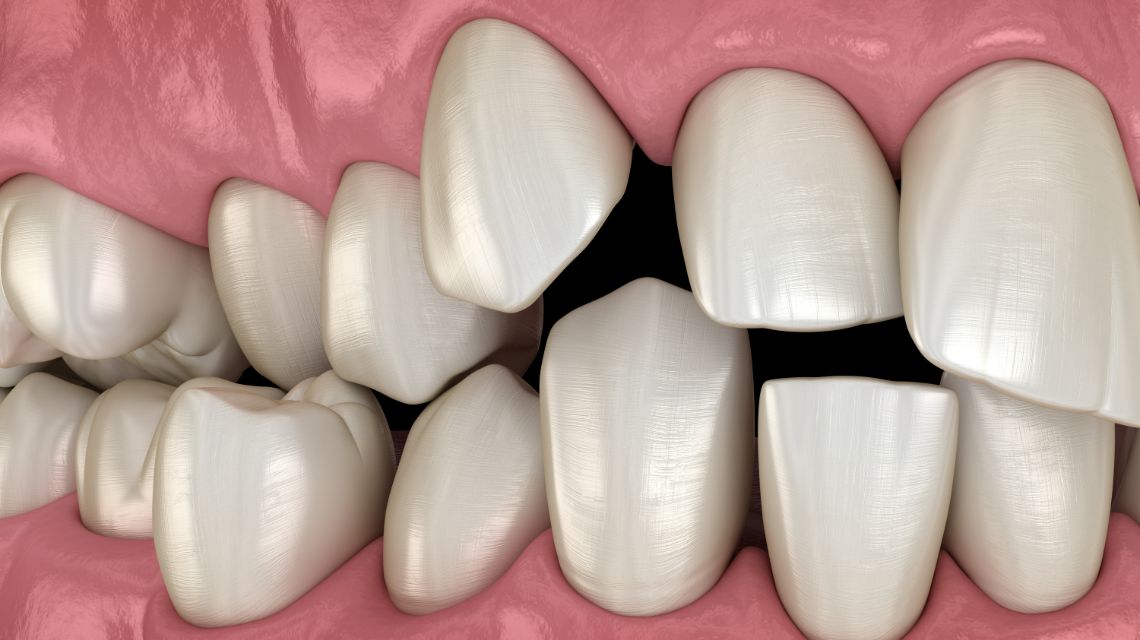
Most people with irregular teeth look for their nearest dental clinic to see an orthodontist. Irregular or poorly aligned teeth, a condition called malocclusion, give rise to several tooth and gum problems while affecting your smile and require a thorough orthodontic evaluation by a specialist in the best dental clinic in Bangalore. If you want to correct your teeth alignment, book your consultation with the best dentist in Bangalore at Apollo Dental.
What are the Types of Malocclusions?
The most common malocclusions that a dentist in the best dental clinic in Bangalore encounters are:
- Crowding
When there is a lack of space in either jaw, the teeth are crowded, often causing overlaps.
- Spacing
When there is more than sufficient space in either jaw, the teeth are aligned with the spaces between them. The most common spacing between the upper front teeth is midline diastema.
- Open bite
When the upper teeth fail to overlap the lower teeth, it is called an open bite.
- Deep bite
When the upper teeth overlap the lower teeth over 2mm, it is called a deep bite.
- Overjet
It is called an overjet when the upper front teeth extend horizontally beyond the lower front teeth horizontally.
- Crossbite
When the lower teeth overlap the upper teeth, it is called a crossbite. It can be generalized or localized.
- Rotations
When the teeth are rotated in their position, they affect the aesthetics of a smile and make it difficult to brush and floss them, increasing the risk for tooth and gum problems.
What Symptoms Do Malocclusions Cause?
The most common symptoms of malocclusion that may prompt you to visit the best dental hospital in Bangalore are:
- An unaesthetic smile that makes you conscious
- Difficulty in biting or chewing
- Speech problems, with the lisp being the most common issue
- Mouth breathing
- Jaw joint (TMJ) problems
- Inability to chew properly
What Are the Causes of Malocclusions?
Malocclusions can be caused by the following:
- Hereditary or genetic factors
- Cleft lip and palate
- Habits like tongue thrusting, thumb-sucking
- Prolonged use of a pacifier or bottle-feeding beyond three years of age
- Jaw trauma
- Poor dental fillings, crowns, or other dental appliances
- Failure to wear retainers after a braces treatment
- Force applied by erupting wisdom teeth that disrupt teeth alignment
When do you need to see a doctor?
If your irregularly aligned teeth make you conscious or affect your dental health, book your consultation with an expert orthodontist at the best dental clinic in Bangalore. Request an appointment at Apollo Dental, Bangalore. Call 18001020288 to book an appointment.
What Are the Possible Complications of Malocclusions?
If left untreated, malocclusions can cause the following complications:
- Gum disease
- Tooth decay
- Irritation in the gum
- Difficulty in speaking and eating
- Discomfort during other dental treatments
- Loss of self-confidence
Can Malocclusions be Prevented?
Some malocclusions like those caused by habits or non-replacement of missing teeth can be prevented, but most malocclusions are untreatable. However, early diagnosis and prompt treatment at a dental clinic can avoid additional problems.
How Are Malocclusions Treated?
Malocclusions require treatment by an orthodontist. Standard treatment options include:
- Braces
- Removable orthodontic appliances
- Removal of one or more teeth in crowding cases
- Reshaping or restoring old dental restorations and appliances
- Surgery to align the jaws
Conclusion
Very few people are born with picture-perfect, well-aligned teeth. If you are unhappy with your teeth alignment, visit the best dental doctor in Bangalore for an evaluation.
Request an appointment at Apollo Dental, Bangalore. Call 18001020288 to book an appointment.
While a routine clinical evaluation can help your orthodontist or dentist determine the type of malocclusion you have, they may prescribe X-ray tests to study the relationship between your facial skeleton, jaws, and teeth alignment.
Malocclusions have been grouped under three classes: Class I: When the upper molar is just ahead of the lower molar. Class II: When the upper molar is far ahead of the lower molar and teeth are forwardly placed. Class III: When the lower molar is ahead of the upper molar and the lower jaw appears forwardly placed.
Your malocclusion treatment depends upon several factors like the type of malocclusion, degree of severity, and the type of treatment chosen. While braces take around 1-1.5 years, cosmetic treatments like veneers used to treat mild malocclusions take a shorter time.
Types of Malocclusion Doctors in Bengaluru
BDS,MDS...
| Experience | : | 14 Years Experience |
|---|---|---|
| Speciality | : | Orthodontics & Dentofacial Orthopaedics... |
| Location | : | Kadubesenahalli |
| Timings | : | Mon - Sat : 10:00 AM... |
BDS, MDS - Orthodont...
| Experience | : | 4+ Years Experience |
|---|---|---|
| Speciality | : | Orthodontics & Dentofacial Orthopaedics... |
| Location | : | Electronic City Phase 1 |
| Timings | : | On Call... |
BDS, MDS - Orthodont...
| Experience | : | 4+ Years Experience |
|---|---|---|
| Speciality | : | Orthodontics & Dentofacial Orthopaedics... |
| Location | : | Basavangudi |
| Timings | : | On Call... |
BDS, MDS - Orthodont...
| Experience | : | 4+ Years Experience |
|---|---|---|
| Speciality | : | Orthodontics & Dentofacial Orthopaedics... |
| Location | : | Seshadripuram |
| Timings | : | On Call... |
BDS, MDS - Orthodont...
| Experience | : | 4+ Years Experience |
|---|---|---|
| Speciality | : | Orthodontics & Dentofacial Orthopaedics... |
| Location | : | Whitefield |
| Timings | : | On Call... |
BDS, MDS - Orthodont...
| Experience | : | 4+ Years Experience |
|---|---|---|
| Speciality | : | Orthodontics & Dentofacial Orthopaedics... |
| Location | : | JP Nagar |
| Timings | : | On Call... |
BDS, MDS - Orthodont...
| Experience | : | 4+ Years Experience |
|---|---|---|
| Speciality | : | Orthodontics & Dentofacial Orthopaedics... |
| Location | : | HSR Layout |
| Timings | : | On Call... |
BDS, MDS - Orthodont...
| Experience | : | 4+ Years Experience |
|---|---|---|
| Speciality | : | Orthodontics & Dentofacial Orthopaedics... |
| Location | : | Bannerghatta |
| Timings | : | On Call... |
BDS, MDS - Orthodont...
| Experience | : | 14+ Years Experience |
|---|---|---|
| Speciality | : | Orthodontics & Dentofacial Orthopaedics... |
| Location | : | Harlur main Road |
| Timings | : | Mon to Sat : 09:00 A... |
BDS, MDS - Orthodont...
| Experience | : | 14+ Years Experience |
|---|---|---|
| Speciality | : | Orthodontics & Dentofacial Orthopaedics... |
| Location | : | Balagere Road Varthur |
| Timings | : | Mon to Sun : On Call... |
BDS, MDS - Orthodont...
| Experience | : | 14+ Years Experience |
|---|---|---|
| Speciality | : | Orthodontics & Dentofacial Orthopaedics... |
| Location | : | Sarjapur Yamare |
| Timings | : | Mon to Sun : On Call... |
BDS, MDS - Orthodont...
| Experience | : | 14+ Years Experience |
|---|---|---|
| Speciality | : | Orthodontics & Dentofacial Orthopaedics... |
| Location | : | Sarjapur Main Road |
| Timings | : | Mon to Sun : On Call... |


























































